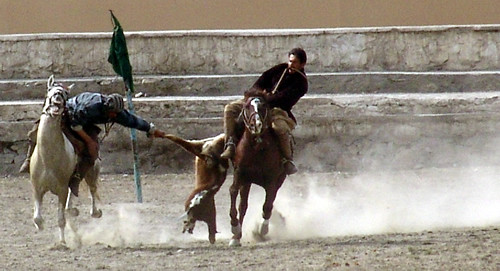Buzkashi
The national sport of Afghanistan

Sassan Tabatabai
Imagine the game of polo, where two opposing teams on horseback use a long mallet to strike a small ball through the opponent’s goal. Polo or chowgan (the game of kings) as it is known by its original Persian name is thought to have developed in the Persian court as early as the 6th century BCE as an offspring of training exercises for the cavalry, in particular the elite guard surrounding the king. It is a sport that has retained its popularity and maintained its grip on the imagination as a game of skill and cooperation between man and horse. We hear of polo in Ferdowsi’s 10th-century Persian epic, the Shahnameh (Epic of Kings) when the exiled Iranian prince, Seyavash, takes the field with his men against the team fielded by Afrasiyab, the king of Turan, and proves—much to the chagrin of the Turanian court—the superior skill of the Persian players. Today, the sport has become synonymous with the sprawling grass fields of Southern California and Buenos Aires where handsome men dressed in Ralph Lauren uniforms gallop on meticulously groomed horses to the applause of spectators in summer whites.
Now, strip polo of all the characteristics that associate it with high society affluence. Move it from the manicured green lawns of the polo clubs to the dirt fields of Central Asia. Get rid of all the boundaries. Get rid of the shiny helmets and tight-fitting uniforms. Get rid of the mallets. Now, replace the ball with the headless carcass of a goat. What you have is buzkashi (literally “goat pulling”), one of the most popular sports throughout Central Asia and the national sport of Afghanistan.
Buzkashi, which is thought to have originated among the tribes of Northern Afghanistan who would raid each other’s camps and ride away with stolen livestock, is not for the feint of heart. In most iterations of the sport, a goat or calf weighing anywhere between 40-100 lbs is beheaded, gutted, and soaked in cold water overnight to toughen it. Men on horseback attempt to wrest the carcass from each other and drag it to a marked circle, which acts as a goal. In Afghanistan, the buzkashi rider, or chapandaz, uses a short whip to strike his own horse, the opponent’s horse, and the hands and legs of other riders to gain control of the goat. The whip is often carried in the teeth so the chapandaz can use both hands to snatch the goat. The only rule the riders must abide by is that the goat cannot be fastened to the saddle in any way—it has to be carried by hand or tucked under the rider’s leg.
The game usually starts as an all out scrum of horses and riders in the middle of the field until one chapandaz secures the prize and rides out of the crowd towards a designated scoring area. If he is successful and scores, he rides over to one of the sponsors of the match—often a rich, local land owner—where he is given a stack of cash. Then the game resumes and every time a rider scores, he is rewarded in similar fashion, right on the spot. Traditionally, hundreds of riders could participate in the match, which could last for days. The playing field had no fixed boundaries and the scrimmage of stomping hoofs and flying whips would often spill into the crowd of spectators causing havoc and injury.
In recent years, there has been an attempt in Afghanistan to regulate the sport and standardize its rules. Consequently, each team can field ten players who compete for two 45-minute halves on a clearly marked, square field. Outside Kabul, however, the rules are rarely enforced. The rugged chapandaz now compete in one of two main types of buzkashi. The most common is Tudabarai where the rider must gain control of the goat from the central scrum and carry it away in any direction while staying free and clear of other riders. The other, more complex form of buzkashi is Qarajai, where the rider must gain control of the goat and carry it around a flag before depositing it in the scoring circle.
Buzkashi was banned during the rule of the Taliban in Afghanistan (1996-2001) but has been reinstated as the national sport following the ouster of the Taliban in 2001.


